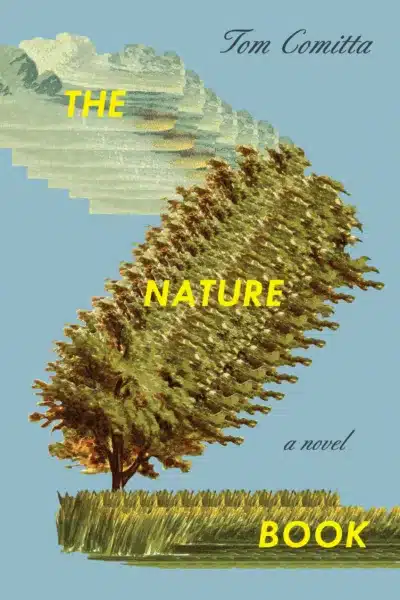By Tom Comitta
Coffee House Press, 2023

Reviewed by JoeAnn Hart
“No words of my own can be added anywhere in the novel,” writes The Nature Book’s author, Tom Comitta, with a nod to the Oulipo group[1] and a whiff of Sol LeWitt[2], as he defines the constraints and rules of this extraordinary novel. Every word, from a short phrase to a few paragraphs, has been cut and pasted from nature scenes lifted from other works of fiction. His organizing principle: “This book collects nature descriptions from English-language novels since the beginning of the novel form.” Three hundred of them, all listed in the back of the book where the rules are posted as well. Read them first. It will help. And yet, The Nature Book is far more than a thought experiment rendered in collage. Yes, it’s an ambitious word project, but it is also majestic in its beauty and ingenious in its conception.
Conceptual art need not involve skilled fabrication or word-smithing, but in this case, it does, even if those words are someone else’s. The phrases have to curated and organized after all, not unlike regular old writing. The selections are then ordered to create narrative tension, with resolutions and a plot, of sorts. Certainly as much plot as I have seen in many other books that do include humans. And for those of us who write about nature, it’s a treasure of images that I fully intend to steal. You can too. And as a reader who pays careful attention to natural descriptions, it was fun to try to guess what books the words were from. I yearned for a cheat sheet, and if there is a fully cited edition somewhere, I am not aware of it. What I did find was a 2020 prepublication excerpt in the LA Review of Books, where you can click on a pdf link of an annotated version of the excerpt, which is unreadable but fascinating. In it you will find one of my favorite bits: “On the other side of the valley, another animal that had lost everything that winter (the wolves were bad that winter, and everyone knew it[3]) came sludging through the snow. It was the sow bear, the mother, a huge, powerful, heavy thing breathing a stale breath of old deer-hides and skunk cabbages and dead mushrooms.” From this short statement, these many sources: The White Peacock, D. H. Lawrence, Life of Pi, Yann Martel, Anne of the Island, Lucy Maud Montgomery, and Blood and Guts in High School, Kathy Acker.
“What happens next?” might be the driving force of novels, and this one is no exception. Splice together enough excerpts about a bear, and you’ve got yourself a story. There is still death and suffering, because that is how the cycle works, but also renewal and joy, because that it also how it works. The Nature Book helps us to understand ourselves by our absence rather than our actions, and encourages us to pay attention to what is often just background music in a novel, a natural setting. Having said that, I take issue with Comitta’s assumption that nature excludes humans, even though, as unnatural as we may seem, we are very much part of nature, so much so that we’ll go down with it when we destroy it. But I get the point. No humans were used in the creation of this novel, where even the wind and water have lives. As it says in one footnote, “nature can put on a thrilling show. The budget for special effects is absolutely unlimited.”
[1] The early 60s French avant-garde group that encouraged the use of literary constraints.
[2] The American artist who wrote about creating rules for conceptual art later in the 60s.
[3] This parenthesis appears as a footnote in the text.
JoeAnn Hart writes about the pervasive and widespread effects of the climate crisis on the natural world and the human psyche. Her most recent book, Arroyo Circle, a story of reclamation in a time of loss, was released by Green Writers Press in 2024. Her other books include the prize-winning environmental and animal fiction collection Highwire Act & Other Tales of Survival, the crime memoir Stamford ’76: A True Story of Murder, Corruption, Race, and Feminism in the 1970s, as well as Float, a dark comedy about plastics in the ocean published by Ashland Creek Press, and Addled, a social satire. She is a regular reviewer of climate and animal fiction at EcoLit Books.

